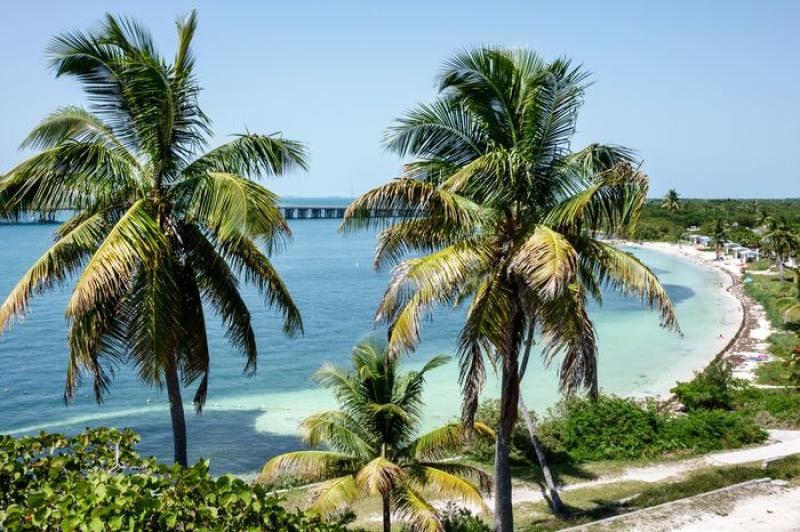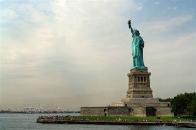From Miami to Key West: A 4-Day Journey Into Old Florida Charm
By: Tony Perrottet (WSJ)



If Ernest Hemingway were sailing, boozing and boxing his way around the Florida Keys today, he might still feel at home in a poetically ramshackle watering hole called Alabama Jack's at the northern entrance to Key Largo. Or so it seemed to me, when I detoured off U.S. Highway 1 south of Miami, abandoning traffic jams and suburbia for the dreamlike solitude of Card Sound Road, where pristine expanses of lush mangrove pressed in on both sides like verdant tidal waves.
I spotted Alabama Jack's half-hidden in the foliage, a solitary roadhouse—part bar, part open-air shack—that juts over glassy waters. Its interior is decorated with dozens of license plates nailed to pillars, a few dangling PVC fishing buoys and sculptural pieces of driftwood, and an impressive mounted marlin. For the next hour, I sat on a bar stool on the deck and watched the sky reflected on inky waters broken only by the splashes of leaping fish.
It was the first sign that exploring the Keys could still offer some piratical Old Florida charm—if I took it slowly. The drive of some 160 miles on Highway 1 from Miami to Key West is an iconic American road trip, but like many travelers, the first time I had tackled it I was in a manic rush. In the 113-mile section through the Keys known as the Overseas Highway, the mix of nature and engineering was so exhilarating—bridges soar above turquoise water and specks of coral, making me feel like I was flying in Chitty Chitty Bang Bang—that I didn’t think to stop on that trip until I hit Mile 0 some four hours later.
Only then did I wonder: What had I missed?
The only way to find out, I realized, was to plan a second trip—this time taking four days instead of four hours to cover the same distance.
Sleepy Marathon
Pulling up at Alabama Jack’s was a promising start. I skipped the rest of Key Largo—which is no longer the atmospheric outpost evoked in the 1948 Humphrey Bogart and Lauren Bacall film noir—and headed south to Marathon, a sleepy township that covers 13 reef-fringed islets in the Middle Keys. Today, it’s devoted to the simple pleasures. At the Keys Fisheries restaurant, I ordered a tuna-steak BLT directly from the window of a fishing cooperative, where the catch is dropped by trawlers onto the pier every morning, and ate with the pelicans and seagulls in the sun.
The nearby Castaway Waterfront Restaurant & Sushi Bar started out in 1951, using beer to steam shrimp delivered to nearby docks. Today it’s run by John Mirabella, a Falstaffian character who has become a celebrity in the Keys for his campaign to harvest lionfish, an invasive species that is devastating the marine environment, and serve them as sushi. Thanks to their poisonous dorsal spines, the lionfish are also extravagantly ugly. In the wood-paneled eatery, a TV plays footage of John scuba diving and spearing the sinister-looking creatures, accompanied by pulsing “Jaws”-like music. I naturally ordered the signature King of the Jungle Roll, made from lionfish, avocado and asparagus garnished with fish roe. It was a daunting sight when it arrived—the lionfish was stretched out like a crucified gargoyle on the plate—but shockingly delicious.
Quirky environmental projects are a Marathon specialty, as I found at the nearby Turtle Hospital, dedicated to saving reptiles that have been injured in car and boating accidents or have developed tumors from water pollution. “This is not SeaWorld,” said a bubbly volunteer guide named Samantha as she led an educational-tour group past a state-of-the-art operating room to outdoor saltwater pools where turtles of all sizes and ages were being nursed back to health. “They want to be in the wild. We focus on release.” She added that whoever rescues an injured turtle is given the right to name it, which is why one brought in by a local teenager was called Little Fat Brihanna.
But for me, the main attraction of Marathon was a relic of its eccentric human history: the Old Seven Mile Bridge. Referred to fondly by locals as Old Seven, it was part of the Overseas Railroad, a titanic early-20th-century project to run iron tracks across the raw tropical landscape from Miami to Key West. The last of the original rail bridges were closed in 1982 and left to rust, except for a 2.2-mile stretch of Old Seven that was kept open for use by fishermen, pedestrians, joggers and cyclists. After a five-year renovation, it reopened with great fanfare in January.
Today, Old Seven is the Keys’ most charming outdoor exercise site, as I found when I woke at dawn to follow a walkway onto the traffic-free span. Its arrow-straight length is blasted with sunshine and sea air; peering over the side, I tried to spot manatees, sharks, dolphins and tarpon in the reefs 18 feet below. At the end, a ramp descends to the 5-acre Pigeon Key, a former workers’ camp where eight wooden cottages survive between swaying palm trees and lawns patrolled by seagulls and ibises. A small museum in a former school room offers antique photos and scale models to explain how outlandish an undertaking the Overseas Railroad was. The vision of an aging robber baron named Henry Flagler, the route took thousands of workers seven years to complete. Marathon itself got its odd name from workers saying the construction was getting to be a marathon—an understatement if ever there was one. Old Seven was the ultimate act of engineering bravura, requiring hundreds of concrete pylons to be sunk into the shifting sands and mangrove swamps between open ocean.
When it opened in 1912, the railroad was hailed as the Eighth Wonder of the World and helped to transform Florida by luring armies of sun-starved Northerners. But it closed in 1935 after a hurricane tore through the Middle Keys, killing hundreds of residents and workers and ripping up some of the tracks. A few years later, the route was paved over for a highway.
Flagler’s dream still haunts the Keys and offers some stunning backdrops. South of Old Seven, in Bahia Honda State Park on Big Pine Key, the golden-sand Calusa Beach lies in the shadow of another grand railway bridge, now off-limits except for a short section. As I dove into the waves, it loomed like a steampunk version of the great Roman aqueduct at Nîmes.
Key West surprises

After all this, arriving in Key West was at first an anticlimax. Taking a deep breath, I dodged the crowds surging into the marina for its pirate-themed diners and all-you-can-drink sunset cruises and headed to the back streets—lounging with a rum in the Green Parrot Bar, watching the flamingos in the Key West Butterfly & Nature Conservatory, visiting President Harry Truman’s Winter White House and paying my respects at the Ernest Hemingway Home and Museum, where six-toed cats lounge in the sun beneath antique photos of the author. (“Papa” lived there for over a decade around the 1930s, a mythic era when rustic-chic fishing camps thrived, bootleggers ran Cuban rum and he could commute in his yacht Pilar to Havana.)
But on my last day, Key West managed to surprise me. Spectacular as the road trip from Miami had been, I had to admit that I hadn’t really delved into the tropical wilderness that made the Keys famous over a century ago. A friend tipped me off about a company called Sunset Watersports, which (he swore) would rent me a motorboat to explore the prelapsarian world of the mangroves far beyond port. This seemed wildly unlikely—drive my own motorboat without a license? But when I turned up at the group’s waterfront shed, it turned out to be perfectly true, even though (no doubt wisely) I had to go in a guided group with six other vessels.
Within minutes, I was behind the wheel, opening the throttle and slapping past some of the hundreds of small Keys in the chain, these ones barely more than mounds of coral rising from the waves. After mooring in waist-high water by ravishing clumps of mangrove, which rose from the crystal-clear water like elegant abstract sculptures, I snorkeled over rippling sand while fish darted between my feet. I felt like an explorer who had stumbled onto a New World.
The Ernest Hemingway Home and Museum in Key West.......PAUL HARRIS/GETTY IMAGES, KAREN BLEIER/AGENCE FRANCE-PRESSE/GETTY IMAGES, TONY PERROTTET
Some places to stay and see
Key Largo
-
Alabama Jack’s : An ideal first stop to get into the laid-back Keys mood, serving cold beer and conch fritters among the mangroves since 1946.
Islamorada
- A good pit stop, often described as Key West without the crowds. At the Islamorada Fish Company , you can eat fine seafood at an open-air bar while watching giant tarpon gather in the waters below.
Marathon
- Isla Bella Beach Resort is located a stone’s throw from the access trail to the Old Seven Mile Bridge. Rooms are decorated with images of Florida birds by John James Audubon, who traveled the islands on extended shooting expeditions to gather models for his watercolors.
- Castaway Waterfront Restaurant & Sushi Bar : This boisterous, wood-paneled seafood restaurant became famous for serving lionfish (an excellent way to strike back at an invasive species), but also dishes up such esoteric delights as Oysters Kyiv (with sour cream, horseradish, and black and red roe) and lobster enchiladas with homemade poblano sauce.
- The Turtle Hospital has visits by tour only; adults $30, children ages 4-12, $15, free under 4.
- Old Seven Bridge to Pigeon Key has access on foot or bike, or by electric tram, $25.
- For a drink after the visit to Pigeon Key, the Sunset Grille and Raw Bar is a great ramshackle local watering hole, with modest prices and million-dollar views.
Big Pine Key
- Bahia Honda State Park : In the surreal shadow of a bridge from the 1912 Overseas Highway, this is a dreamy spot for sunbathing, snorkeling, kayaking and spotting an array of birds including plovers, snowy egrets, hawks and the endangered white-crowned pigeon; entry $8 per vehicle.
Key West
- The classic Old Florida hotel is the majestic Casa Marina , a high-society hub for the island since 1920, hosting presidents, Hollywood stars and European aristocrats.
- A more economical new entry is the Cuban-themed Havana Cabana .
- Sunset Watersports ’ half-day Safari Eco Tour is a good way to delve into pristine nature; $178 for one or two people, a third rider under 40 pounds can be added for $44.








